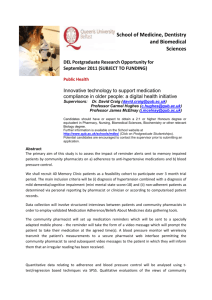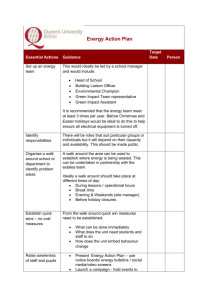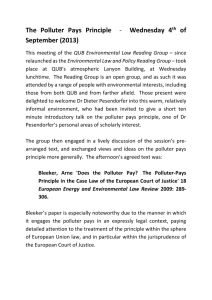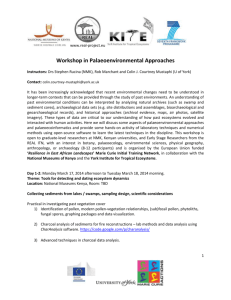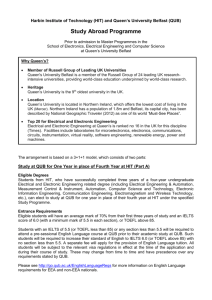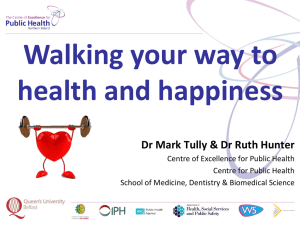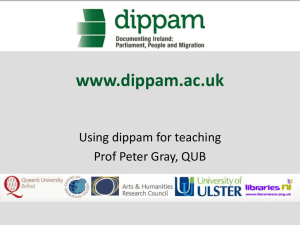Cii Summer Studentship Projects 2014 Principle Investigator (PI)
advertisement
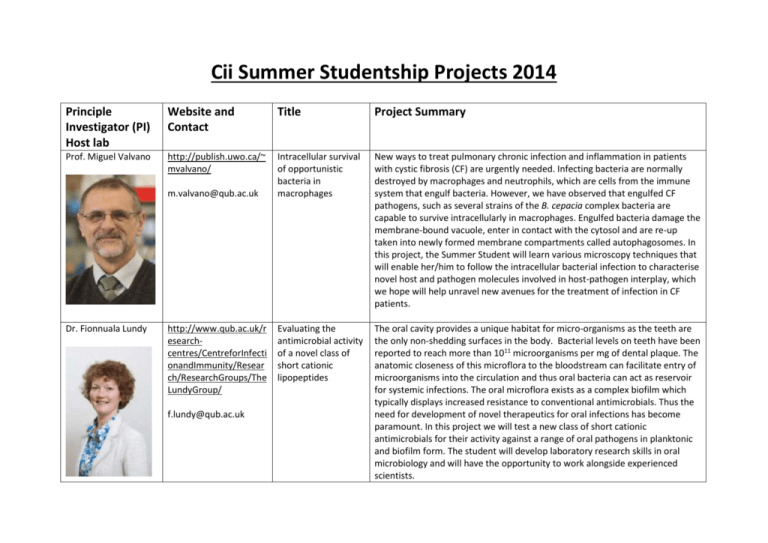
Cii Summer Studentship Projects 2014 Principle Investigator (PI) Host lab Website and Contact Title Project Summary Prof. Miguel Valvano http://publish.uwo.ca/~ mvalvano/ Intracellular survival of opportunistic bacteria in macrophages New ways to treat pulmonary chronic infection and inflammation in patients with cystic fibrosis (CF) are urgently needed. Infecting bacteria are normally destroyed by macrophages and neutrophils, which are cells from the immune system that engulf bacteria. However, we have observed that engulfed CF pathogens, such as several strains of the B. cepacia complex bacteria are capable to survive intracellularly in macrophages. Engulfed bacteria damage the membrane-bound vacuole, enter in contact with the cytosol and are re-up taken into newly formed membrane compartments called autophagosomes. In this project, the Summer Student will learn various microscopy techniques that will enable her/him to follow the intracellular bacterial infection to characterise novel host and pathogen molecules involved in host-pathogen interplay, which we hope will help unravel new avenues for the treatment of infection in CF patients. Evaluating the antimicrobial activity of a novel class of short cationic lipopeptides The oral cavity provides a unique habitat for micro-organisms as the teeth are the only non-shedding surfaces in the body. Bacterial levels on teeth have been reported to reach more than 1011 microorganisms per mg of dental plaque. The anatomic closeness of this microflora to the bloodstream can facilitate entry of microorganisms into the circulation and thus oral bacteria can act as reservoir for systemic infections. The oral microflora exists as a complex biofilm which typically displays increased resistance to conventional antimicrobials. Thus the need for development of novel therapeutics for oral infections has become paramount. In this project we will test a new class of short cationic antimicrobials for their activity against a range of oral pathogens in planktonic and biofilm form. The student will develop laboratory research skills in oral microbiology and will have the opportunity to work alongside experienced scientists. m.valvano@qub.ac.uk Dr. Fionnuala Lundy 1. http://www.qub.ac.uk/r esearchcentres/CentreforInfecti onandImmunity/Resear ch/ResearchGroups/The LundyGroup/ f.lundy@qub.ac.uk Dr. Denise Fitzgerald http://www.qub.ac.uk/r esearchcentres/CentreforInfecti onandImmunity/Resear ch/ResearchGroups/The FitzgeraldGroup/ The role of inflammasomes in brain repair Myelin is the protecting sheath around neurons that facilitates signal conduction in the brain. Damage to myelin (demyelination) can have devastating outcomes such as permanent disability and blindness. Currently, there is no cure for demyelinating diseases such as Multiple Sclerosis (MS). Our neuroimmunology research group is identifying novel therapeutic targets to repair myelin in the brain in MS. Inflammasomes are multi-protein complexes that process the pro-inflammatory cytokines IL-18. Inflammasomes are known to drive inflammation in animal models of MS. Brain repair is partly dependent on inflammation however, to date it is not known if inflammasomes play a role in brain repair. This project aims to understand the role of inflammasomes in remyelination in animal models of demyelination. This work will contribute to the understanding of how the innate immune system facilitates brain repair. This research could have implications for developing future therapeutics for the treatment of Multiple Sclerosis. Investigation of the mechanism of upregulation of transient receptor potential (TRP) cation channels by respiratory virus envelope proteins. Members of the transient receptor potential (TRP) cation channel family, expressed in cell types in the lung are known to regulate the tussive response to airway irritants and are important in asthma. We have recently shown that TRP channels are up-regulated by respiratory virus infection. Measles virus (MV) and respiratory syncytial virus (RSV) induce soluble factors which alone are capable of TRPV1 (TRP channel) up-regulation. However, non-infectious virus particles were also found to up-regulate TRPV1. Membrane Toll like Receptors (TLRs) respond to specific microbial components, including proteins found on virus envelopes, and induce cytokines. The envelope proteins haemagglutinin (H) of MV and fusion (F) protein of RSV are known to interact with TLR2 and TLR4, respectively. Our hypothesis is that virus envelope proteins up-regulate TRP channels by activating particular membrane TLRs. The student would investigate this with a view to new therapeutic strategies for respiratory virus infection including asthma exacerbations. d.fitzgerald@qub.ac.uk y.dombrowski@qub.ac. uk Prof. Louise Cosby 1. http://www.qub.ac.uk/r esearchcentres/CentreforInfecti onandImmunity/Resear ch/ResearchGroups/The CosbyGroup/ l.cosby@qub.ac.uk Dr. Bettina Schock http://www.qub.ac.uk/r esearchcentres/CentreforInfecti onandImmunity/Resear ch/ResearchGroups/The SchockGroup/ Induction of zinc finger protein A20: Investigating compounds with anti-inflammatory action The zinc finger protein A20 regulates NFinfection. In CF epithelial cells, A20 expression and function is reduced, and accompanied by persistent activation of NFcytokines. We have identified Gibberellin (GA), a diterpenoid, to induce A20/ZnF proteins, thereby exerting anti-inflammatory properties. Using bioinformatics (connectivity mapping) we have now identified further compounds and drugs, some of them already licensed for use in humans that would induce A20. This project will test the ability of the predicted compounds to induce A20 in airway epithelial cells. Results of this work will help to assign new anti-inflammatory functions to already existing drugs (drug repositioning). Techniques employed include sterile working, cell culture, qPCR (mRNA for A20 and p65) Western Blotting (A20) and ELISA (pro-inflammatory cytokines). Anti-inflammatory zinc finger protein A20: Mechanism of action. The zinc finger protein A20 regulates NF-kappaB activation in response to bacterial infection. In CF epithelial cells, A20 expression and function is reduced, and accompanied by persistent activation of NF-kappaB and release of inflammatory cytokines. We have identified Gibberellin (GA), a diterpenoid, to induce A20/ZnF proteins, thereby exerting anti-inflammatory properties. However, the mechanism of action of A20 is not fully understood, especially as A20 itself is induced via NF-kappaB (p65 subunit). Phosphorylation of p65 can modifying the activity of NFA20 has been shown to increase through phosphorylation of p65 on serine536. Our hypothesis is that GA pre-treatment changes the phosphorylation on p65 upon LPS stimulation, thereby enhancing the expression of anti-inflammatory A20. Techniques employed include sterile working, cell culture and Western Blotting (A20, phospho p65 protein) and ELISA (pro-inflammatory cytokines). b.schock@qub.ac.uk Dr. Bettina Schock http://www.qub.ac.uk/r esearchcentres/CentreforInfecti onandImmunity/Resear ch/ResearchGroups/The SchockGroup/ b.schock@qub.ac.uk Prof. Jose Bengoechea https://sites.google.co m/site/bengoechealabo ratory/ Is there a way to treat infections without antibiotics? In the UK, respiratory infections are the leading cause of infectious disease mortality and morbidity. This problem is getting worse by growing numbers of multidrug-resistant microorganisms, the so-called superbugs. Antimicrobial resistance is not only a major UK health problem but a global one as highlighted by the World Health Organization. Therefore, there is a need to develop effective therapeutics based on new approaches. In this ground-breaking project, we will explore whether by targeting the strategies employed by the superbugs to manipulate our host defences system we can eradicate the infection without need of antibiotics. To address this hypothesis, we will use our recently developed infection model of the wax moth Galleria mellonella. Larvae will be infected with the superbug Klebsiella pneumoniae and then treated with drugs that block the host molecules targeted by Klebsiella already discovered by my laboratory. Determining the antiviral potential of a novel antirespiratory syncytial virus (RSV) nanobody. RSV is the principal viral cause of severe lower respiratory tract disease in infants and young children. However, there are no vaccines or specific therapeutics available against this virus. As part of a research project funded by a biotech company, we are studying the therapeutic potential of a novel nanobody against RSV infection of well-differentiated primary paediatric bronchial epithelial cell cultures (WD-PBECs). Nanobodies are recombinant single variable chains derived from functional Ilamas antibodies composed of only heavy chains. WD-PBECs are airway epithelial cell cultures that look and behave like they would in the lungs. Airway epithelial cells are the primary targets for RSV infection in infants. This project will help to generate data necessary to support the hypothesis that the novel anti-RSV nanobody has therapeutic potential by titrating apically-release RSV by infection assays and quantitative RT-PCR assays and quantifying cytopathogenesis following RSV infection of nanobody treated and untreated WD-PBECs. j.bengoechea@qub.ac.u k Dr. Ultan Power 1. http://www.qub.ac.uk/r esearchcentres/CentreforInfecti onandImmunity/Resear ch/ResearchGroups/The PowerGroup/ u.power@qub.ac.uk Dr. Tammie Schneiders http://www.qub.ac.uk/r esearchcentres/ CentreforInfectionandI mmunity/Research/Res earchGroups/TheSchnei dersGroup/ Strategies to limit Antimicrobial Resistance in Gramnegative bacteria t.schneiders@qub.ac.uk Dr. Beckie Ingram http://www.qub.ac.uk/r esearchcentres/CentreforInfecti onandImmunity/Resear ch/ResearchGroups/The IngramGroup/ Treg control of Th9 and Th2 cells b.ingram@qub.ac.uk Dr. Beckie Ingram http://www.qub.ac.uk/r esearchcentres/CentreforInfecti onandImmunity/Resear ch/ResearchGroups/The IngramGroup/ b.ingram@qub.ac.uk Using a Wax Moth larvae model to investigate the role of the lung microbiome in the pathogenicity of Pseudomonas The emergence and spread of antimicrobial resistance in bacteria now presents the stark reality that continued antibiotic treatment is under threat. This is especially relevant in gram-negative bacteria, where the situation has reached crisis point, resulting in an increasing reliance on last resort agents. Klebsiella pneumoniae is a significant gram-negative nosocomial pathogen which is a major cause of bacteraemia in the UK (http://www.bbc.co.uk/news/health21737844) and due to rising resistance levels presents an increasing challenge for antimicrobial therapy. Antimicrobial resistance in K. pneumoniae can occur either through target specific mutations or via the increased expression of intrinsic mechanisms. These intrinsic mechanisms generally confer a pan-drug resistance phenotype linked to perturbations of influx and efflux mechanisms. Studies also link the elevated levels of these regulators to pleiotropic phenotypes, which impact on microbe-drug interactions. Thus the challenge is to elucidate how intrinsic systems facilitate microbial survival in the face of continued antibiotic challenge. Regulatory T cells (Tregs) are the control system for the immune response. When they function correctly they prevent damage to surrounding tissues during an immune response to infection and the development of autoimmunity. There is a clear understanding of how Tregs control the wellcharacterised Th1 and Th2 helper T cell subsets. However in the last few years there has been a huge expansion of the number of distinct Th subsets identified. This project will explore the ability of Tregs to suppress the activity of the more recently identified Th9 and Th22 subsets. The project will include cell culture, proliferation assays, ELISA and flow cytometry. It is now well established that the gut microbiome has a huge impact on the human immune response. An interaction between the gut commensal bacteria and immune system has the ability to greatly alter the immune response to pathogenic bacteria either positively or negatively. The human lung was previously thought to be a sterile site in the absence of active infection. With the advent of modern deep sequencing techniques it is now known that this isn’t the case and there is a diverse bacterial community within the lung. This project will use a moth larvae model to examine if these lung commensal organisms alter the virulence of lung pathogenic bacteria Pseudomonas.
